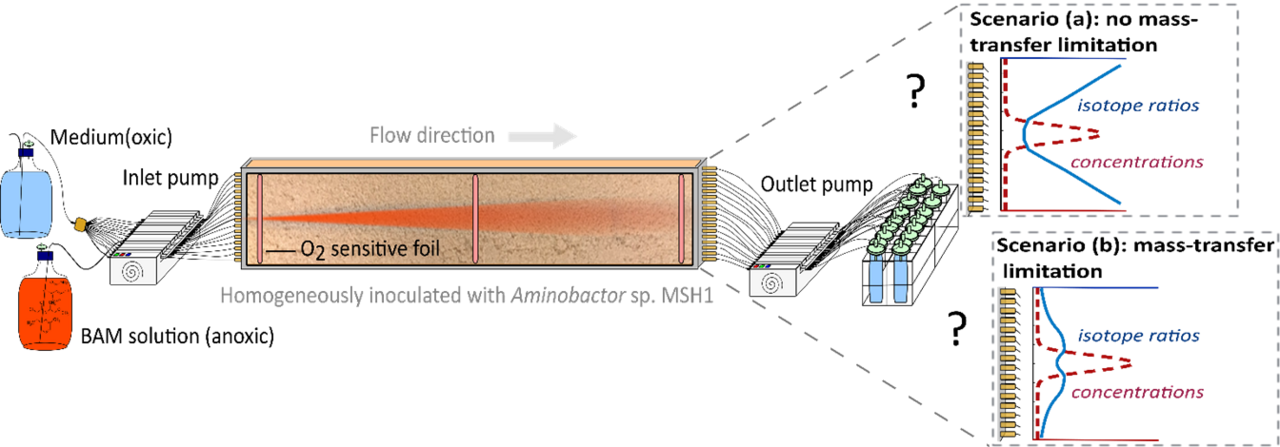ERC MicroDegrade: Insight from Bench-Scale Aquifer Experiments and Simulation (Work packages 2&3)

CSIA could demonstrate the existence of mass transfer limitations in a quasi-two dimensional sediment tank system mimicking realistic conditions in a natural aquifer. High, unmasked isotope fractionation in the center of the plume indicated that 2,6-dichlorobenzamide degradation by Aminobacter sp. MSH1 was unlimited with respect to substrate, but limited by supply of oxygen. In contrast, reactive transport modelling of masked isotope fractionation pinpointed mass transfer limitations during cellular uptake as rate-determining step in degradation of 2,6-dichlorobenzamide towards the lower end of the concentration profile. (Sun et al., 2021 b) In parallel, dedicated diffusion and dispersion experiments could exclude the possibility of artefacts from isotope effects of aqueous diffusion and dispersion. This suggests that the potential influence of aqueous diffusion on isotope profiles in contaminant hydrology has been exaggerated in recent years (Sun et al., 2021a).
Publications:
- K. Fenner, M. Elsner, T. Lueders, M. McLachlan, L. Wackett, M. Zimmermann, J. Drewes, Methodological advances to study contaminant biotransformation: new prospects for understanding and reducing environmental persistence?, ACS ES+T Water (2021), accepted.
- F. Sun, A. Mellage, M. Gharasoo, A. Melsbach, X. Cao, R. Zimmermann, C. Griebler, M. Thullner, O. Cirpka, M. Elsner, Mass Transfer-Limited Biodegradation at Low Concentrations – Evidence from Reactive Transport Modeling of Isotope Profiles in a Bench-Scale Aquifer, Environ. Sci. Technol. 55 (2021), pp. 7386–7397;
DOI: https://doi.org/10.1021/acs.est.0c08566 (b) - F. Sun, J. Peters, M. Thullner, O. A. Cirpka, M. Elsner, Magnitude of Diffusion- and Transverse Dispersion-Induced Isotope Fractionation of Organic Compounds in Aqueous Systems, Environ. Sci. Technol. 55 (2021), pp. 4772–4782; DOI: 10.1021/acs.est.0c06741 (a)
- K. Kundu, Nina Weber, Ch. Griebler, M. Elsner, Phenotypic heterogeneity as key factor for growth and survival under oligotrophic conditions, Environmental Microbiology 22 (2020), pp. 3339-3356,DOI: 10.1111/1462-2920.15106
- S. Marozava, A. Meyer, A. Perez-de-Mora, M. Gharasoo, L. Zhuo, H. Wang, O. Cirpka, R. Meckenstock, and M. Elsner, Mass Transfer Limitation During Slow Anaerobic Biodegradation of 2-Methylnaphthalene, Environ. Sci. Technol. 53 (2019) pp. 9481-9490, DOI:10.1021/acs.est.9b01152
- K. Kundu, S. Marozava, B. Ehrl, J. Merl-Pham, Ch. Griebler, M. Elsner, Defining lower limits of biodegradation – atrazine degradation regulated by mass transfer and maintenance demand in Arthrobacter aurescens TC1, The ISME Journal 13 (2019) pp. 2236–2251 DOI: 10.1038/s41396-019-0430-z
- B. Ehrl, K. Kundu, M. Gharasoo, S. Marozava, M. Elsner, Rate-Limiting Mass Transfer in Micropollutant Degradation Revealed by Isotope Fractionation in Chemostat, Environ. Sci. Technol. 53 (2019) pp. 1197–1205, DOI: 10.1021/acs.est.8b05175
- M. Gholami Gharasoo, B. Ehrl, O. Cirpka, M. Elsner, Modeling of contaminant biodegradation and compound-specific isotope fractionation in chemostats at low dilution rates, Environ. Sci. Technol. 53 (2019) pp. 1186–1196, DOI: 10.1021/acs.est.8b02498
- B.N. Ehrl, E.O. Mogusu, K. Kim, H. Hofstetter, J.A. Pedersen, M. Elsner, High Permeation Rates in Liposome Systems Explaining Glyphosate Biodegradation Associated with Strong Isotope Fractionation, Environ. Sci. Technol. 52 (2018), pp. 7259-7268, DOI: 10.1021/acs.est.8b01004
- B.N. Ehrl, M. Gharasoo, M. Elsner, Isotope Fractionation Pinpoints Membrane Permeability as a Barrier to Atrazine Biodegradation in Gram-negative Polaromonas sp. Nea‑C, Environ. Sci. Technol. 52 (2018), pp. 4137-4144, DOI: 10.1021/acs.est.7b06599
- M. Elsner, G. Imfeld, Compound-specific Isotope Analysis (CSIA) of Micropollutants in the Environment - Current Developments and Future Challenges; Current Opinion in Biotechnology, 41 (2016) pp 60–72, http://dx.doi.org/10.1016/j.copbio.2016.04.014 (invited contribution to the special issue: “Analytical Biotechnology, Stable Isotope Probing”)